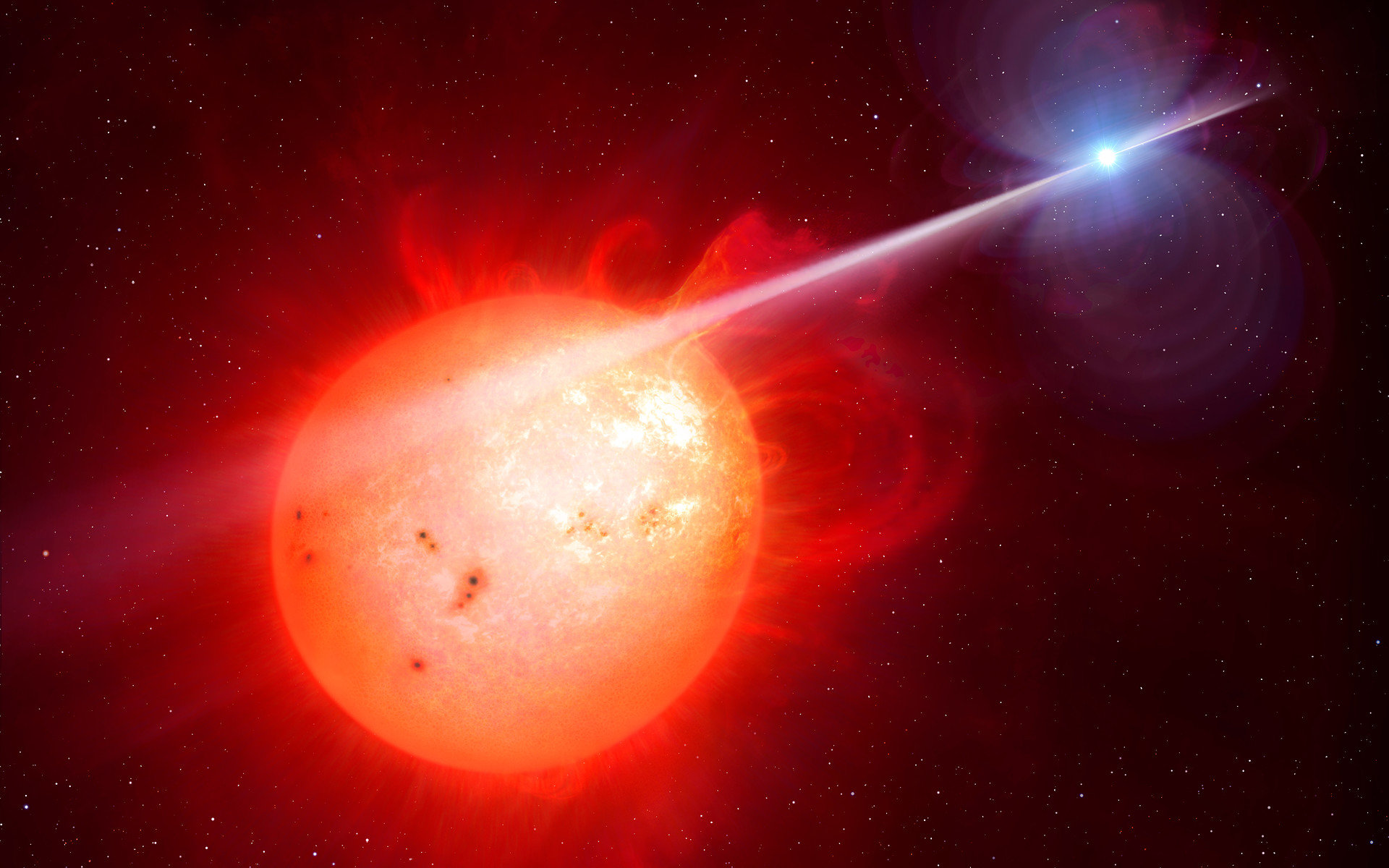
The star system AR Scorpii, or AR Sco for short, lies in the constellation of Scorpius, 380 light-years from Earth. It comprises a rapidly spinning white dwarf [2], the size of Earth but containing 200 000 times more mass, and a cool red dwarf companion one third the mass of the Sun [3], orbiting one another every 3.6 hours in a cosmic dance as regular as clockwork.
In a unique twist, this binary star system is exhibiting some brutal behaviour. Highly magnetic and spinning rapidly, AR Sco's white dwarf accelerates electrons up to almost the speed of light. As these high energy particles whip through space, they release radiation in a lighthouse-like beam which lashes across the face of the cool red dwarf star, causing the entire system to brighten and fade dramatically every 1.97 minutes. These powerful pulses include radiation at radio frequencies, which has never been detected before from a white dwarf system.
Lead researcher Tom Marsh of the University of Warwick's Astrophysics Group commented: "AR Scorpii was discovered over 40 years ago, but its true nature was not suspected until we started observing it in 2015. We realised we were seeing something extraordinary within minutes of starting the observations."
The observed properties of AR Sco are unique. They are also mysterious. The radiation across a broad range of frequencies is indicative of emission from electrons accelerated in magnetic fields, which can be explained by AR Sco's spinning white dwarf. The source of the electrons themselves, however, is a major mystery — it is not clear whether it is associated with the white dwarf itself, or its cooler companion.
AR Scorpii was first observed in the early 1970s and regular fluctuations in brightness every 3.6 hours led it to be incorrectly classified as a lone variable star [4]. The true source of AR Scorpii's varying luminosity was revealed thanks to the combined efforts of amateur and professional astronomers. Similar pulsing behaviour has been observed before, but from neutron stars — some of the densest celestial objects known in the Universe — rather than white dwarfs.
Boris Gänsicke, co-author of the new study, also at the University of Warwick, concludes: "We've known pulsing neutron stars for nearly fifty years, and some theories predicted white dwarfs could show similar behaviour. It's very exciting that we have discovered such a system, and it has been a fantastic example of amateur astronomers and academics working together."
Notes
[1] The observations underlying this research were carried out on: ESO's Very Large Telescope (VLT) located at Cerro Paranal, Chile; the William Herschel and Isaac Newton Telescopes of the Isaac Newton Group of telescopes sited on the Spanish island of La Palma in the Canaries; the Australia Telescope Compact Array at the Paul Wild Observatory, Narrabri, Australia; the NASA/ESA Hubble Space Telescope; and NASA's Swift satellite.
[2] White dwarfs form late in the life cycles of stars with masses up to about eight times that of our Sun. After hydrogen fusion in a star's core is exhausted, the internal changes are reflected in a dramatic expansion into a red giant, followed by a contraction accompanied by the star's outer layers being blown off in great clouds of dust and gas. Left behind is a white dwarf, Earth-sized but 200 000 times more dense. A single spoonful of the matter making up a white dwarf would weigh about as much as an elephant here on Earth.
[3] This red dwarf is an M type star. M type stars are the most common class in the Harvard classification system, which uses single letters to group stars according their spectral characteristics. The famously awkward to remember sequence of classes runs: OBAFGKM, and is often remembered using the mnemonic Oh Be A Fine Girl/Guy, Kiss Me.
[4] A variable star is one whose brightness fluctuates as seen from Earth. The fluctuations may be due to the intrinsic properties of the star itself changing. For instance some stars noticeably expand and contract. It could also be due to another object regularly eclipsing the star. AR Scorpii was mistaken for a single variable star as the orbiting of two stars also results in regular fluctuations in observed brightness.



Reader Comments
to our Newsletter